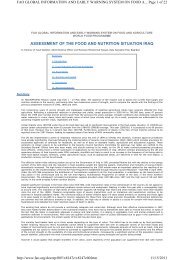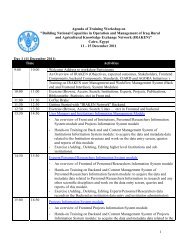Vermiculture in Egypt: - FAO - Regional Office for the Near East and
Vermiculture in Egypt: - FAO - Regional Office for the Near East and
Vermiculture in Egypt: - FAO - Regional Office for the Near East and
You also want an ePaper? Increase the reach of your titles
YUMPU automatically turns print PDFs into web optimized ePapers that Google loves.
Agriculture;<br />
31.72;<br />
16%<br />
Industrial Processes;<br />
;<br />
27.77; 14%<br />
Fuel Combustion<br />
Waste;<br />
17.49;<br />
9%<br />
Fugitive fuel;<br />
10.81; 6%<br />
Fugitive fuel emissions<br />
Figure 7.2. <strong>Egypt</strong>‟s greenhouse gases emissions by sector <strong>for</strong> <strong>the</strong> year 2000, <strong>in</strong> mega<br />
ton CO2 equivalent.<br />
Source: EEAA(2010).<br />
Table (7.3) <strong>and</strong> figure (7.2) show <strong>the</strong> change of sectors‟ contribution to <strong>Egypt</strong>‟s total<br />
<strong>in</strong>ventory. It is clear that <strong>the</strong> total greenhouse gas emissions of <strong>Egypt</strong> <strong>in</strong>creased <strong>in</strong><br />
2000 to be 165% of that <strong>in</strong> 1990. Dur<strong>in</strong>g this period <strong>Egypt</strong>‟s population <strong>in</strong>creased by<br />
123% with an <strong>in</strong>crease <strong>in</strong> <strong>the</strong> GDP of 277% (M<strong>in</strong>istry of Economic Development,<br />
2007). The ratio of GDP, at <strong>the</strong> 1981/82 fixed prices, <strong>for</strong> <strong>the</strong> year 2000 to that <strong>for</strong><br />
1990 is 151%, denot<strong>in</strong>g that <strong>the</strong> <strong>in</strong>crease <strong>in</strong> greenhouse gas emissions seems to be<br />
correlated to <strong>the</strong> GDP <strong>in</strong>crease ra<strong>the</strong>r than <strong>the</strong> population growth. It is clear that<br />
emissions from agriculture are <strong>the</strong> second after fuel combustion <strong>and</strong> be<strong>for</strong>e <strong>in</strong>dustrial<br />
processes.<br />
7.4. Vermifilters <strong>in</strong> domestic wastewater treatment<br />
There is ano<strong>the</strong>r important use that helps <strong>the</strong> environment which is <strong>the</strong> use of<br />
vermiculture as a biological filter <strong>for</strong> domestic waste water. use of earthworms <strong>in</strong><br />
filtration systems, which has been termed vermifiltration (VF) (X<strong>in</strong>g et al., 2010).<br />
S<strong>in</strong>ce <strong>the</strong>n, several studies have been conducted to evaluate <strong>the</strong> use of vermifilters <strong>in</strong><br />
domestic wastewater treatment, municipal wastewater treatment, <strong>and</strong> sw<strong>in</strong>e<br />
wastewater treatment processes, as well as <strong>in</strong> simultaneous sludge reduction<br />
processes. However, less attention has been given to <strong>the</strong> use of vermifilters to dispose<br />
of excess sludge directly. Moreover, most studies conducted to evaluate VFs have<br />
only focused on <strong>the</strong> contam<strong>in</strong>ation purification efficiencies, but <strong>the</strong> <strong>in</strong>teractions<br />
between earthworms <strong>and</strong> microorganisms, which are very important <strong>for</strong> underst<strong>and</strong><strong>in</strong>g<br />
<strong>the</strong> sludge stabilization mechanisms <strong>in</strong>volved <strong>in</strong> VFs, have not been fully <strong>in</strong>vestigated.<br />
A study was conducted to explore <strong>the</strong> feasibility of us<strong>in</strong>g a VF to stabilize sewage<br />
sludge while focus<strong>in</strong>g on elucidat<strong>in</strong>g <strong>the</strong> earthworm–microorganism <strong>in</strong>teractions<br />
responsible <strong>for</strong> <strong>the</strong> decomposition of organic matter <strong>in</strong> <strong>the</strong> vermifilter. Additionally,<br />
this <strong>in</strong>vestigation sought to identify <strong>the</strong> primary mechanism by which sewage sludge<br />
stabilization <strong>in</strong> <strong>the</strong> vermifilter occurs based on <strong>the</strong> chemical <strong>and</strong> spectroscopic<br />
69<br />
Industrial Processes<br />
Fuel Combustion;<br />
105.51;<br />
55%<br />
Agriculture<br />
Waste





